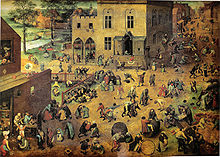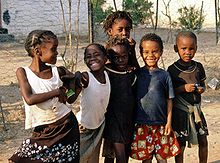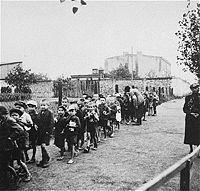- Child
-
Biologically, a child (plural: children) is generally a human between the stages of birth and puberty. Some vernacular definitions of a child include the fetus, as being an unborn child.[1] The legal definition of "child" generally refers to a minor, otherwise known as a person younger than the age of majority. "Child" may also describe a relationship with a parent or authority figure, or signify group membership in a clan, tribe, or religion; it can also signify being strongly affected by a specific time, place, or circumstance, as in "a child of nature" or "a child of the Sixties".[2]
Contents
Legal, biological, and social definitions
The United Nations Convention on the Rights of the Child defines a child as "a human being below the age of 18 years unless under the law applicable to the child, majority is attained earlier".[3] Ratified by 192 of 194 member countries. Some English definitions of the word 'child' include the fetus and the unborn.[4] Biologically, a child is anyone between birth and puberty or in the developmental stage of childhood, between infancy and adulthood. Children generally have fewer rights than adults and are classed as not able to make serious decisions, and legally must always be under the care of a responsible adult.
As a non-adult
Recognition of childhood as a state different from adulthood began to emerge in the 16th and 17th centuries. Society began to relate to the child not as a miniature adult but as a person of a lower level of maturity needing adult protection, love and nurturing. This change can be traced in painting: In the Middle Ages, children were portrayed in art as miniature adults with no childish characteristics. In the 16th century, images of children began to acquire a distinct childish appearance. From the late 17th century onwards, children were shown playing. Toys and literature for children also began to develop at this time.[5]
Attitudes toward children
Social attitudes toward children differ around the world in various cultures. These attitudes have changed over time. A 1988 study on European attitudes toward the centrality of children found that Italy was more child-centric and Holland less child-centric, with other countries, such as Austria, Great Britain, Ireland and West Germany falling in between.[6]
Socialization
All children go through stages of social development. An infant or very young child will play alone happily. If another child wanders onto the scene, he or she may be physically attacked or pushed out of the way. Next, the child is able to play with another child, gradually learning to share and take turns. Eventually the group grows larger, to three or four children. By the time a child enters kindergarten, he or she is usually able to join in and enjoy group experiences.[7]
Children with ADHD and learning disabilities may need extra help in developing social skills. The impulsive characteristics of an ADHD child may lead to poor peer relationships. Children with poor attention spans may not tune in to social cues in their environment, making it difficult for them to learn social skills through experience.[8] Today, in many countries like Canada and the United States, children twelve and older are held responsible for their actions and may be sent to special correctional institutions, such as juvenile hall.
Surveys have found that at least 25 countries around the world have no specified age for compulsory education. Minimum employment age and marriage age also vary. In at least 125 countries, children aged 7–15 may be taken to court and risk imprisonment for criminal acts. In some countries, children are legally obliged to go to school until they are 14 or 15 years old, but may also work before that age. A child's right to education is threatened by early marriage, child labour and imprisonment.[9]
Child mortality
Children rounded up for deportation to the Chełmno extermination camp. Some 1.5 million Jewish children were murdered by the Nazis.
During the early 1600s in England, life expectancy was only about 35 years, largely because two-thirds of all children died before the age of four.[10] During the Industrial Revolution, the life expectancy of children increased dramatically.[11]
According to population health experts, child mortality rates have fallen sharply since the 1990s. Deaths of children under the age of five are down by 42% in the United States, while Serbia and Malaysia have cut their rates by nearly 70%.[12]
One child policy
- See also: Two-child policy
China's one-child policy forces some couples to have no more than one child. China's population policy has been credited with a very significant slowing of China's population growth which had been higher before the policy was implemented. It has come under criticism that the implementation of the policy has involved forced abortions and forced sterilization. However, while the punishment of "unplanned" pregnancy is a fine, both forced abortion and forced sterilization can be charged with intentional assault, which is punished with up to 10 years' imprisonment. If born with another child and kept, parents must pay a large fine for every day he/she is alive.
See also
Listen to this article (info/dl)
This audio file was created from a revision of Child dated 2008-06-24, and does not reflect subsequent edits to the article. (Audio help)More spoken articles- Childlessness
- Child sexual abuse
- Index of youth articles
- Outline of children
References
- ^ See Shorter Oxford English Dictionary 397 (6th ed. 2007), which's first definition is "A fetus; an infant;...". See also ‘The Compact Edition of the Oxford English Dictionary: Complete Text Reproduced Micrographically’, Vol. I (Oxford University Press, Oxford 1971): 396, which defines it as: ‘The unborn or newly born human being; foetus, infant’.
- ^ "American Heritage Dictionary". 2007-12-07. http://www.bartleby.com/61/13/C0291300.html.
- ^ “Convention on the Rights of the Child” The Policy Press, Office of the United Nations High Commissioner for Human Rights
- ^ See Shorter Oxford English Dictionary 397 (6th ed. 2007), which's first definition is "A fetus; an infant;...". See also ‘The Compact Edition of the Oxford English Dictionary: Complete Text Reproduced Micrographically’, Vol. I (Oxford University Press, Oxford 1971): 396, which defines it as: ‘The unborn or newly born human being; foetus, infant’.
- ^ Essays on childhood
- ^ Rachel K. Jones and April Brayfield, Life's greatest joy?: European attitudes toward the centrality of children. Social Forces, Vol. 75, No. 4, Jun 1997. 1,239-69 pp. Chapel Hill, North Carolina.
- ^ Socialization stages
- ^ Juvenile courts
- ^ Melchiorre, A. (2004) At What Age?...are school-children employed, married and taken to court?
- ^ W. J. Rorabaugh, Donald T. Critchlow, Paula C. Baker (2004). "America's promise: a concise history of the United States". Rowman & Littlefield. p.47. ISBN 0742511898
- ^ "Modernization - Population Change". Encyclopædia Britannica.
- ^ Child mortality rates dropping
External links
Human Development: Biological • Psychological Pre- and perinatal BiologicalPsychologicalInfancy BiologicalPsychologicalInfant and child psychologyChildhood BiologicalPsychologicalAdolescence BiologicalPsychologicalYoung adulthood PsychologicalMiddle adulthood BiologicalMaturity BiologicalPsychologicalLegal and general definitions Theorists and theories Articles of the Universal Declaration of Human Rights General principles Article 1: Freedom, Egalitarianism, Dignity and Brotherhood
Article 2: Universality of rightsInternational Covenant on Civil and Political Rights Article 1 and 2: Right to freedom from discrimination · Article 3: Right to life, liberty and security of person · Article 4: Freedom from slavery · Article 5: Freedom from torture and cruel and unusual punishment · Article 6: Right to personhood · Article 7: Equality before the law · Article 8: Right to effective remedy from the law · Article 9: Freedom from arbitrary arrest, detention and exile · Article 10: Right to a fair trial · Article 11.1: Presumption of innocence · Article 11.2: Prohibition of retrospective law · Article 12: Right to privacy · Article 13: Freedom of movement · Article 14: Right of asylum · Article 15: Right to a nationality · Article 16: Right to marriage and family life · Article 17: Right to property · Article 18: Freedom of thought, conscience and religion · Article 19: Freedom of opinion and expression · Article 20.1: Freedom of assembly · Article 20.2: Freedom of association · Article 21.1: Right to participation in government · Article 21.2: Right of equal access to public office · Article 21.3: Right to universal suffrage
International Covenant on Economic, Social and Cultural Rights Article 1 and 2: Right to freedom from discrimination · Article 22: Right to social security · Article 23.1: Right to work · Article 23.2: Right to equal pay for equal work · Article 23.3: Right to just remuneration · Article 23.4: Right to join a trade union · Article 24: Right to rest and leisure · Article 25.1: Right to an adequate standard of living · Article 25.2: Right to special care and assistance for mothers and children · Article 26.1: Right to education · Article 26.2: Human rights education · Article 26.3: Right to choice of education · Article 27: Right to science and culture ·
Context, limitations and duties Article 28: Social order · Article 29.1: Social responsibility · Article 29.2: Limitations of human rights · Article 29.3: The supremacy of the purposes and principles of the United Nations
Article 30: Nothing in this Declaration may be interpreted as implying for any State, group or person any right to engage in any activity or to perform any act aimed at the destruction of any of the rights and freedoms set forth herein.Categories:- Childhood
- Children
- Developmental psychology
- Humans
Wikimedia Foundation. 2010.






